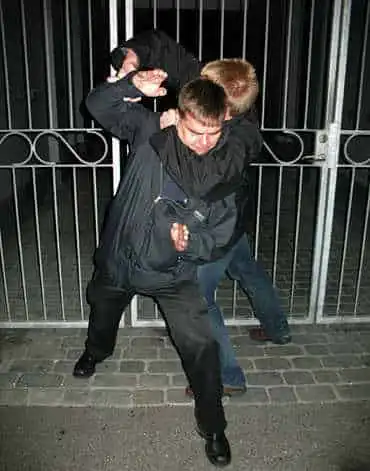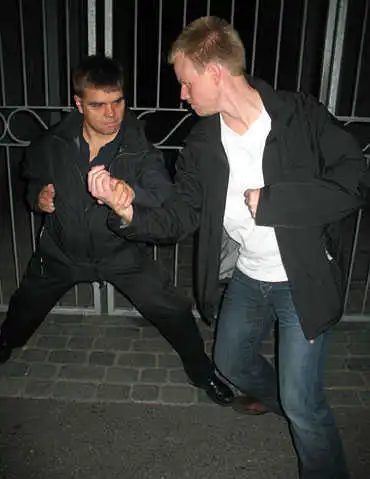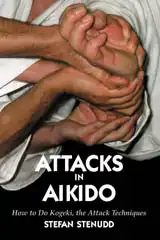Aikido as Self-Defense Elusive Realism in TrainingI first came across aikido as a teenager, and was immediately taken by the genius of its martial art principles — its strategy, if you will. Taisabaki, the evasive movement, would work against the most ferocious charge. Aiki, the joining of forces instead of opposing them, would work against the strongest attacker. It was obvious to me that these principles were the only ones with the potential of a limitless martial art. It was equally obvious why such a super-strategy was possible at all, and that was an enchanting circumstance: It is only accessible for defense purposes. Attackers cannot apply it. So, the ultimate martial art needs to be based on non-aggression. That's so sweet it could be turned into a religion. So, very early on I got convinced that aikido is the ultimate martial art — where peace is the goal. And I saw numerous confirmations, in the dojo and outside of it. I have still seen nothing that would change my conviction. Not that it's acquired in a blink. But that's true for just about everything in the universe. What's easily attained is of little value. The basic aikido strategy of the taisabaki evasive movement needs to be exercised so persistently that it becomes a reflex. The aiki joining of forces needs to be learned so profoundly that it becomes at least as smooth as water. Only when it becomes like air, you're home. But it's quite possible, and you need to be neither an athlete nor a genius. Already after a few years of training, most aikido students have reached significant capabilities — often without being aware of it. That, too, is a charming trait of aikido: its practitioners underestimate its power.
The ultimate self-defenseThrough the years since I started with aikido in the early 1970s, there has been a massive increase in the number of martial arts practiced in the world, and even more of an increase of practitioners. A contest of sorts is going on between many of those martial arts, as to which one is the most effective: the quest for the ultimate self-defense.Mostly, this has taken place among martial arts that compete, and therefore seek a winner. That's something completely different from not losing, which is what self-defense is about. Those who want to win need to attack, so the aikido strategy is out of their reach, whereas those who only want to avoid being defeated can still access it. Nonetheless, many of the arguments about self-defense effectiveness are actually based on competition fight paradigms. Mainly, the defender is expected to stick to a set of rules and techniques that apply to the martial art in question. Usually the defender is devoid of the element of surprise — especially when trying a certain predetermined technique against the attack. Regular dojo training is quite remote to a self-defense situation, mainly because the attacker, uke, trusts the defender, tori (and vice versa). Therefore, none of them will act with either the precaution or the decisiveness that would otherwise be necessary.
RealismTo examine self-defense aspects, we need to recreate authentic parameters. It is usually called realism. Realism in martial arts training refers to actual out-of-dojo self-defense — the attack by a thug who will not cooperate in the least, but go at you with raw malicious intent.That's not easy to copy in a dojo, nor is it very pleasant. We don't accept practice that is bound to cause serious harm. But that's not all. More importantly: It is simply very difficult, if not impossible, to track and repeat all the true ingredients of street violence. Many more things than what meets the eye are at play, and the importance of them are quite different from what's the case in orderly dojo practice. One such aspect of immense importance is the attacker's instinct of self-preservation. No matter how angry, he is certainly not prepared to die just for the chance of giving you a black eye. Probably, he wouldn't do it if it cost him a broken arm, either. Actually, very few people attack others without being convinced that they will succeed — and at a low cost to their own health. They pick their victims carefully. Also, they tend to sort of test their adversary before springing into action. This initial ingredient of self-defense situations is almost impossible to practice in a dojo, because uke is not given the option of not attacking at all. But in aikido, this is at the core of its basic philosophy. We aim to do away with violence altogether, so we should really practice how to make the presumptive attacker refrain from it. It can be practiced, but it has to be done with a certain sensitive awareness in uke as well as tori, and with attention to other things completely, than the mechanics of pinnings and throws. Only by methods that we usually call spiritual, can we exercise how to avoid being attacked at all. Posture and attitude are decisive in this. So is the direction of our intent.
AtemiAlso when a fight has commenced, the self-protective urge of the attacker is present — and even more acute. He will react instinctively to serious threats. He can't help it. Aikido is full of methods to manipulate those reactions, mainly by atemi, the strike.Now, the power and importance of atemi is rarely understood in regular dojo training, because uke doesn't have to worry about those strikes actually hitting. But in order to achieve self-defense realism, uke must react to the atemi as an aggressor would. That's a kind of acting, of releasing one's instincts, which takes serious practice to accomplish, and it's still never more than almost realistic. It should be understood that atemi is the most useful for creating a reaction in the attacker. To actually strike somebody out with an atemi is not that easy. It can be done, but only with great force, precision, and skill. Still, it's not as reliable as one might imagine. Knocking somebody out is rarely as swift as in the movies.
AdrenalineAnother complicated aspect in realism is the nature of the attacker's pursuit. In martial arts competitions, where both are aware of the other one's abilities and techniques, attacks tend to be quite reserved. Very often they're just feints intended to create an opening. That's not the case with real-life aggressions.Somebody who really wants to hurt you moves in a very committed way, attacking with force, less concerned with retreat. There are several reasons for this. Primarily, anything else would be insufficient to reach the intended conclusion — defeating the victim. Also, real violence is a big step to take. It needs to be triggered by anger and adrenaline. So, the attacker needs this commitment in order to be able to attack at all. There are some people who can attack without anger, but still they need both instinctual support and some adrenaline rush to do it. The vast majority of mankind needs it in abundance. Therefore, real attacks are almost always very committed, not reserved at all. And if they fail, they are not followed by retreats, but immediate additional attacks. This can be copied in a dojo, and that's how most dojos normally practice: a clear and committed attack, and a remaining attacking spirit in uke that keeps him or her from retreating — at least for a little while.
PainSo, the first and most decisive elements of any self-defense situation are mental and instinctual, not physical at all. The physical aspects, too, are rather difficult to practice realistically in a dojo, and many mistakes are made.For example, there is often an exaggerated belief in pain. Aikido has several pain-inducing techniques, such as yonkyo, nikyo, and sankyo, as well as almost all the end pinnings, osae. But real aggressors have an adrenaline rush, so pain is actually the least effective method of defense. They hardly feel it, and can ignore it even if they do. Yonkyo can only have an effect by the surprise of it, and even that is uncertain. On the other hand, nikyo and sankyo can control the attacker because these joint twists affect his body movements, as a matter of pure mechanics. Also, these techniques can cause a reaction in the attacker if he feels the risk of the wrist breaking. For that purpose the technique can't be done too fast. If nikyo or sankyo are done very fast, the attacker will believe the wrist already to be broken, and he will act accordingly. Only if the technique is slow enough for the attacker to have a chance to react, it will work without breaking the wrist — and just breaking a wrist is no way to succeed in self-defense. Another widespread belief is in the knockout power of punches and kicks. Certainly, somebody very skilled at such techniques can end a fight with it. But it has to be right on a sensitive body target, and the opponent can't move with it at all or have time to adjust in other ways. Otherwise, even powerful strikes are less effective than imagined by several practitioners of striking arts, like karatedo or taekwondo. Again, adrenaline makes a shield of resistance. Also, perfect strikes are not that easy on moving targets. People inexperienced with the martial arts tend to depreciate aikido as self-defense because these refined techniques take so long to learn. Why not punch or kick instead? But effective punches and kicks also take long to learn. An insufficient strike only aggravates the opponent more.
UkemiThe aikido throws are often trained in a way that take ukemi for granted. Uke knows how to fall, without being the least bit harmed by it, so he or she will readily do that when pushed out of balance. But there are no tatami on the streets, and hoodlums are rarely familiar with ukemi, so most throws have to be modified in order to work.Generally speaking, the throws are usually much less trustworthy as self-defense than the pinnings. But throws are great fun, and they look cool, so the students in aikido classes usually favor them. Well, teachers do, too. Many seem to be overconfident in the throws for self-defense, and doubt very much that the pinning techniques work at all. Mae ukemi, forward falling, is an aikido thing. People without that training would just stumble forward, and maybe fall flat on their faces. In most cases, they would definitely get back up again. So, such throws are not likely to complete a defense. Backward throws are different. They are usually such that tori can assure uke's end position. Also, they are much more dangerous to an untrained attacker, since they easily cause a serious blow to the back head when the attacker hits ground. That knocks most people out. In addition, they are often easier to follow up with a pinning, mainly because the attacker lands closer to the defender. In modern aikido, there is a tendency in some dojos to make all throws so that they lead to mae ukemi, and never ushiro. That is very pleasant in keiko, but it is less recommendable in self-defense applications. Because of our ukemi training, we have severe misconceptions about the effectiveness of the throws, and we tend to underestimate the difficulty in making throws reliable. I would say that the more similar a throw is to a pinning, the trustworthier it is in self-defense. Kotegaeshi is a good example of a throw that most aikido students trust a bit too much for self-defense purposes. The forward break-fall is a dojo thing, not to be expected with an attacker in the street. He would either remain standing and break his wrist instead, which has limited self-defense consequence, or just crumble to the ground, soon to get up again. So, in most cases kotegaeshi must be done in a way that leads to osae, the end pinning, in order to complete a self-defense. That also means a backward fall is to prefer. This way of doing kotegaeshi is not so spectacular, but a safer choice in self-defense.
Wrists and armsA lot of aikido techniques contain wrist manipulations, e.g. the above-mentioned kotegaeshi, nikyo, and sankyo. But to manipulate a wrist you need to catch it and hold on to it. That's not easy in a self-defense situation.It can be done, even safely so, but you have to get your priorities right. Arms move fast and unpredictably. The body they are connected to is easier to catch, and its movements are easier to predict. Also, an arm without a body is no danger, but the body is able to do many things even when one of its arms is locked. Therefore, in self-defense one should primarily strive to control the attacker's body, and only secondarily try a technique on a wrist or an arm, if the situation allows for it. And it often does — if you get your priorities right.
 On the other hand, when aikido students test aikido in randori or other resistance exercises, uke tends to protect the arms more than the body — moving them away even when it means exposing vital parts of the body to attacks. That's not realistic at all. All human beings have an instinct to use the arms to protect the body, and that's a very wise instinct. No damage to an arm is immediately lethal, but several damages to the body sure are. Some aikido schools make a method out of this. They use atemi to bring out a blocking move from the attacker, and then swiftly apply the aikido technique to the blocking arm. It works fine. I dare say that through this and other methods, there's no big problem to get hold of one of the attacker's arms. Again, that's an argument for trusting pinning techniques more than aikido students normally do.
ExtremesWhen self-defense issues are discussed among martial artists, they tend to jump to unlikely extremes. Often the attacker is supposed to be an incredibly skilled fighter, who knows everything about the martial arts and how to counter them. But that's rarely the case.Few experienced martial artists take their arts to the streets. It would embarrass them to do so. Whatever martial art they practice, they are very likely to pick up some self-restraint along the way. Of course there are some exceptions, but the risk of running into one of them is minute. Those who actually pick fights in bars and such are mostly untrained in the martial arts, or they would have moved away from such habits — whether they wanted to or not. Instead, they are persons wrestling with personal frustrations, and if they've had any fighting experience it's usually with people of less skill than their own. For self-defense purposes, it's not very meaningful to prepare for battle with champions. Actually, it's counterproductive. It leads to strategies and actions that apply to dojo randori and such, but work less well on "amateurs" in the streets. An expert can lose against an ignorant, who tends to do things that are unexpected because they are strategically inferior. It's important to be aware of this risk. In street fights, sophisticated strategies are hard to find, but instinctual behavior is everywhere — actually often also among the skilled martial artists. In a moment of crisis, instinct tends to take over. This is particularly important to understand about weapons. An attacker in the street who hurries to pull up a knife immediately reveals two things: a need to increase the odds of succeeding with the attack, and a trust in the weapon doing the job for him. These are actually weaknesses, which can be explored by the defender. That is true for any weapon. Therefore, self-defense against armed attacks must focus on the attacker and not the weapon. Well, that's easier said than done. But it should be understood. Furthermore, an armed attacker in the street is unlikely to be a highly trained expert on his weapon. This should also be considered. Even if the weapon is in a very skilled hand, it's the mind of that hand controlling it. That's the real adversary, and not the weapon.
Multiple attackersOne extreme that's not at all unlikely in a self-defense situation, is an attack by more than one person. Such situations are always very dangerous, and often have a terrible ending.Still, this scenario is not discussed that frequently in self-defense speculations, and few martial arts practice it with any regularity. Although it's part of the aikido curriculum as taninzugake, I have the impression that not many aikido dojos practice it as frequently as needed for learning something substantial about it. Mostly, it's just done in dan examinations and at demonstrations. In the case of multiple attackers, some defense strategies that otherwise are quite successful may prove very disadvantageous indeed. For example, the defender should absolutely avoid getting down on the ground. A group of attackers would easily overcome a defender on the ground, even in the unlikely event that they don't remain standing. Pinning techniques are of limited use, since they tend to be slower than throws. And there's little point in holding one attacker in a lock, when others are charging. Contrary to defense against one attacker, throws are generally to prefer against multiple attackers. Obviously, a decisive use of atemi might also be necessary. Psychological and instinctual aspects apply to multiple aggressors, just as much as in defense against one. They usually have a leader, whose actions and reactions are almost automatically copied by the others. Although they are many, they need an initial conviction of succeeding without severe personal risks, and they have the disadvantage of needing to avoid harming each other. Such things can be used against them. But it's far from easy.
Fear and courageI jump back to the mental aspects of self-defense, because it needs to be stressed that they are the most important ones by far. They are also the most difficult ones to practice with any certainty.Still, it's my impression not only that it can be done, but that it's actually done in most budo dojos, as part of the regular curriculum. It may be quite unawares, but it's there. What is the struggle for survival in the animal kingdom, we translate to fear and courage. The former creates our incentive to stay alive, and the latter is our means of doing so. It's not always possible to tell them apart. Fear turns to courage in a moment of crisis, and courage turns to fear when a fatal risk suddenly becomes evident. They definitely have the same source, which is probably none other than the fundamental drive to survive, which every animal possesses. Anyway, they are at work in self-defense situations — on both sides of the fence. The aggressor needs to overcome his fear in order to take the risk of attacking, since the outcome is rarely dead certain. The defender needs to control the fear in order to exercise any skills learned in a dojo. Both cases can be described as courage. The attacker's fear is often neglected in speculations about realistic self-defense, as if nonexistent. But nobody is without fear. When awakened, it influences our behavior and actions tremendously. An aggressor can be overcome by fear and flee, or instantly change from indecision to a ferocious assault. Unfortunately, the outcome is unpredictable. Fear is just as likely to lead to attack as to retreat. That's true for most animals, if not all. Some aggressors hurry to attack, because they suspect that otherwise their own fear might incapacitate them. So, if they are not challenged, they are less likely to spring into action. On the other hand, if they feel no threat at all, they have no reason to expect the emergence of their fear. The defender would need to signal trouble, but no threat.
Pride and shameAnother emotion involved in aggression is pride. It may be one of the most important motivations. People are prepared to risk a lot in order to defend their pride.Since fear is often regarded as a reason for shame, and courage something to be proud of, pride is usually present on both sides of a self-defense situation. The defender would do best not to get occupied by pride, because that clogs the judgment and limits the options. The aggressor might be convinced to avoid confrontation, if he senses that it may end shamefully. On the other hand, pride is exactly what makes the aggressor the most unwilling to back away. The defender should therefore try to find an ending that spares the attacker's pride, or he will be a much more bitter and persistent adversary.
Aikido advantagesAs must be obvious from the above, I have the highest respect for aikido as a method of self-defense. Its strategic principles and many of the ingredients in its practice are quite adaptable to self-defense situations, although many of its techniques may seem awkward or hazardous.Certainly, there's no guarantee. There never is. But aikido has several self-defense advantages, which are not that obvious in a dojo. They are at work already before an aggression is even initiated. Also, they remain way past the moment of the outcome. Of course, these strategic advantages are only at play if they are properly exercised in the dojo. To do so, it's not necessary to transform the aikido classes into self-defense enactments. It's enough that we practice with keen awareness of the inherent adaptability of aikido, and what it really teaches about a situation of opposing wills. In short: we need to trust aikido. Instead of rushing to randori and similar exercises, we can safely go on with kata training, making the basic techniques and movements as natural to us as reflexes. We can sharpen our techniques through kaeshiwaza, counter technique exercises, and learn to handle resistance by practicing henkawaza, shifting from one technique to another. We improve at adapting to different attackers through kakarigeiko, several uke in a row, and to multiple attackers through taninzugake. All the tools for learning self-defense are already part of the aikido curriculum. That's true also for learning the important mental aspects of both the attacker and the defender. Persistent training of the basics develops the ability to perform them calmly even in tense situations. This calmness actually diminishes the risk of being attacked at all. So, stay in your center and remain in the spirit of aiki. That'll do it.
Stefan Stenudd
AIKIDO PRACTICEIntroductionAikido Techniques — all the basic movesAttacks in Aikido
Tantodori — knife defenseAikiken — aikido sword techniquesJo 31 Kata in four directionsAikibatto sword and staff exercisesAiki — joining energiesKi exercisesAikido Video ClipsAikido PhotosMy aikido dojo in Malmö, SwedenMy aikido seminarsAIKIDO THEORYMy Aikido BioAikido GlossaryTanden, the CenterAikido InksAikido as Self-DefenseRunning a DojoAikido is TrueOsensei and EinsteinAikiWeb ColumnsAikido Books ReviewedDie deutsche Version meines Aikido-Buches onlineAikido på svenskaAbout CookiesMy Other WebsitesCREATION MYTHSMyths in general and myths of creation in particular.
TAOISMThe wisdom of Taoism and the Tao Te Ching, its ancient source.
LIFE ENERGYAn encyclopedia of life energy concepts around the world.
QI ENERGY EXERCISESQi (also spelled chi or ki) explained, with exercises to increase it.
I CHINGThe ancient Chinese system of divination and free online reading.
TAROTTarot card meanings in divination and a free online spread.
ASTROLOGYThe complete horoscope chart and how to read it.
MY AMAZON PAGE
MY YOUTUBE AIKIDO
MY YOUTUBE ART
MY FACEBOOK
MY INSTAGRAM
MY TWITTER
STENUDD PÅ SVENSKA
|
 Aikido Principles
Aikido Principles Attacks in Aikido
Attacks in Aikido Aikibatto
Aikibatto
